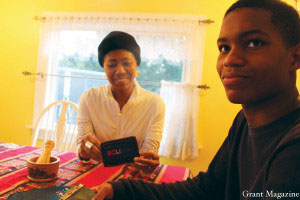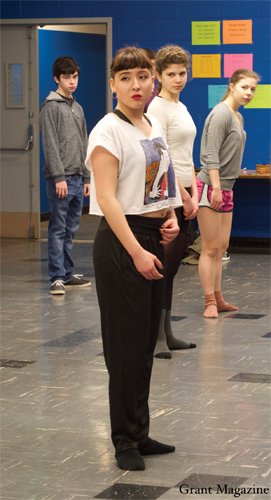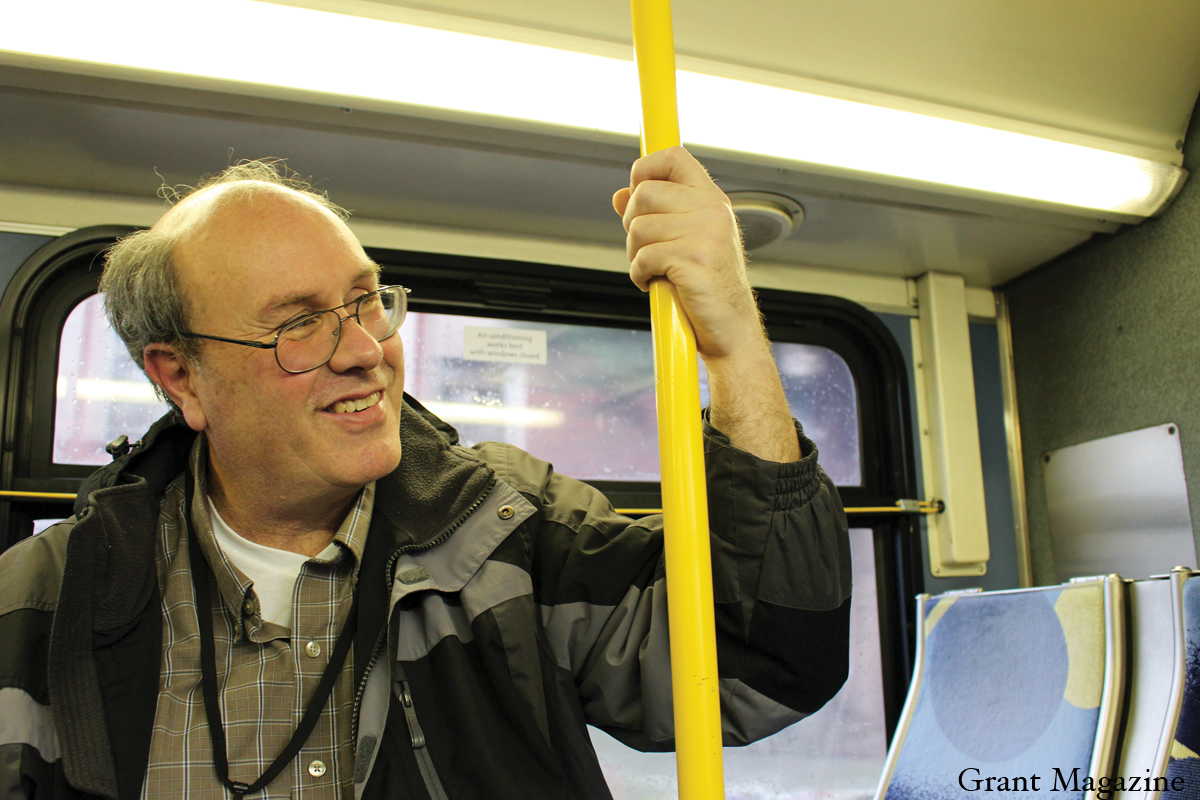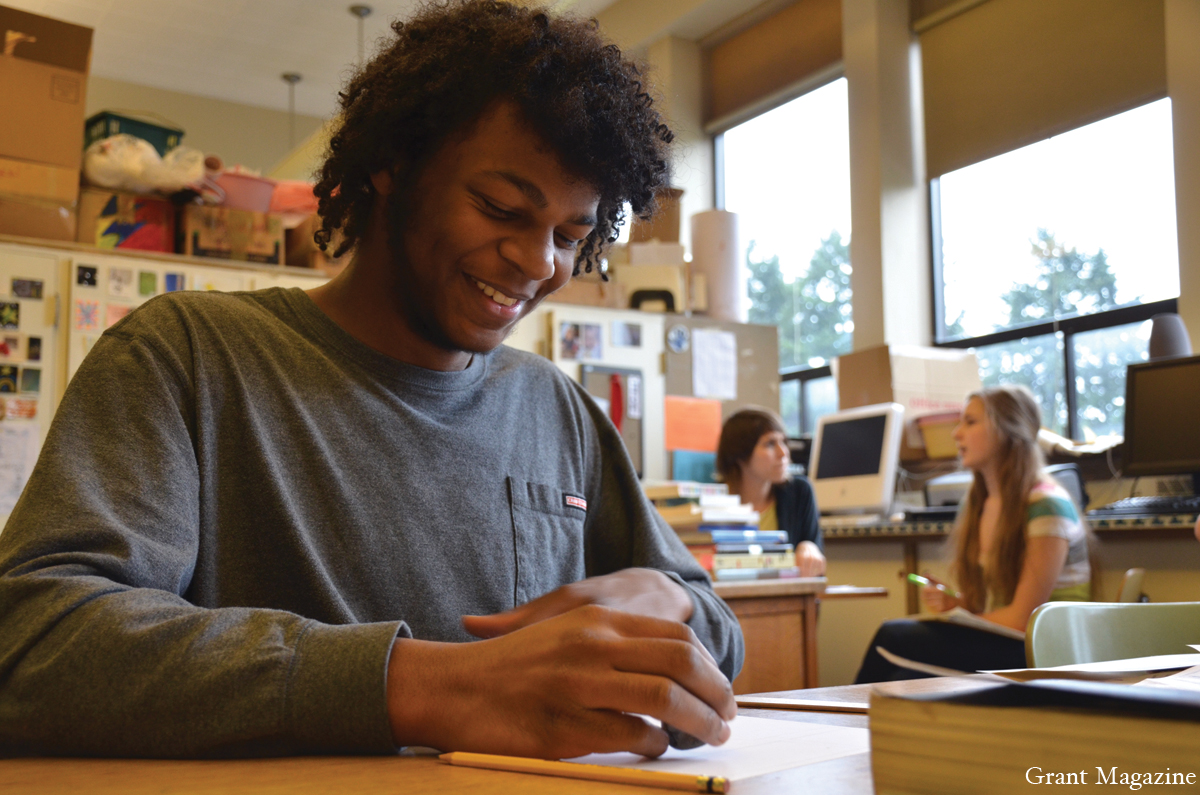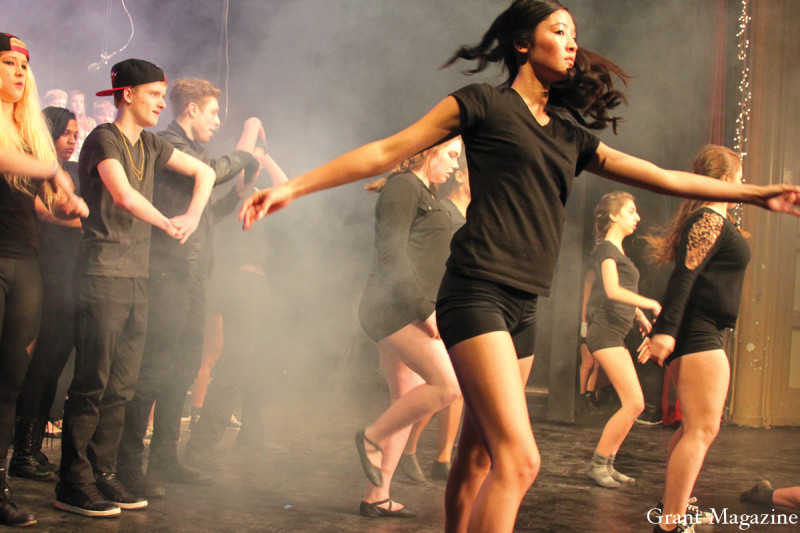
On a weary Friday morning, students are coming one by one into a little known classroom beneath the gym. Music blasts on a stereo as two dancers twist and contort their bodies to the thumping bass.
Mirrors along the wall reflect each student – some stretch, some dance and others chat as they get ready for class. Under the music, there’s a buzz of energy emitting from the room.
Jessica Murray, the first-year class’s teacher, walks into the room. All heads turn to her. She walks to the front of the room. The students know the routine and form several lines adjacent to the mirrors. Murray changes the song on the stereo to something more upbeat and energizing, and they all begin to stretch.
Welcome to Grant’s dance class.
This year, for the first time ever, Grant is offering a dance class, called Hip Hop Dance. In this day of budget cuts – where arts are usually one of the first things to go – dance classes in high school are rare. Don’t let the name fool you. Hip Hop Dance is just a title. Students venture into a variety of different styles from all over the world.
The class merges skill levels, too. Experience isn’t required to take the class, so newcomers dance alongside veterans. Murray’s motto – “Anyone can dance” – says it all.
“We’re trying to make arts acceptable to all students,” says 34-year-old Murray. “It’s less about technique and a lot more focused on sharing dance, exploring dance and creating dances.”
A year ago, Murray had no idea she would end up teaching dance at Grant. She had taught dance and theater at West Linn High School but decided she needed a change. She only took the job at Grant “last minute” when the new dance class was added to the curriculum.
When she arrived, no one had any idea of what Grant’s dance program should look like. “Perhaps the former principal had a vision of what she wanted,” Murray says now of Vivian Orlen, who came up with the idea. “But with her gone, it was like, what should the dance program be?”
Murray knew she didn’t want her class to resemble a studio, and she didn’t want to just focus on one style. As a child, Murray tried ballet, but it was too structured for her. She discovered hip-hop dance as a teenager by watching MTV videos. “I really like exploring a lot of different dance styles,” she says.
Diversity is one of the key elements in her class. Many of her students have never ventured far from their own styles. Thus, you have hip-hop dancers learning ballet and ballerinas learning how to twerk. “I push them outside of their comfort zone sometimes,” Murray admits.
It is impossible to ignore the camaraderie of the class, something that can be hard to find in intense dance studios. “It’s more than, you dance and that’s fun,” says Murray. “It is about connections with the students, setting up an environment where everyone is welcome.”
Of the dozens of students enrolled in Hip Hop Dance, we took a look into the lives of three classmates. What does dance mean to them? One has been dancing for years. Another uses dance as an escape from her family life. Regardless of what drives them, they share one trait: a passion for dance. ♦
The Nomad
Even when it’s cold and drizzling outside, freshman Kenny Wilson is out on his trampoline. He bounces, performing a series of flips and moves. Water collects across the trampoline surface, but Wilson splashes it everywhere with one large flip.
The trampoline helps him with his moves. Wilson is a newcomer to dance but he’s taken to it quickly. He hangs out in the class and practices just about every day.
But Wilson isn’t your average Grant dancer. He moved to Portland last August. Before that, he lived in a number of different countries across the globe. His family shares a passion for travel and they move all over the world.
Born in Port-au-Prince, the capital of Haiti, Wilson lived there for four years until the family moved to St. Croix, an island in the Caribbean. He lived there for two years and then moved to Bolivia. The family later returned to St. Croix.
He experienced some hardships along the way.
“I would make good friends and then I would have to move. I would stay in touch and they would want me to come back and visit, but I couldn’t.” – Kenny Wilson
Bruce Wilson, Kenny’s stepfather, says adapting hasn’t been too tough for his stepson to handle. He is “a person very focused on he wants to do,” says Bruce Wilson. “As a result he tends to be very positive all the time. It’s very easy for him to meet friends.”
Despite living on a picturesque island, Wilson was not entirely satisfied with St. Croix. “The whole island is basically forest life,” Wilson says. “You can go to the beach and play volleyball, but there is not a whole lot you can do. It’s kind of boring.”
He said it wasn’t at all like city life. He remembers a time when
a man cut down a tree near his house and left it in the road. It was there for days, untouched by anyone.
But he was not destined to stay in St. Croix for much longer.
Wilson’s move to the United States was unexpected. After Hovensa, an oil company in St. Croix, shut down, turmoil ensued. “The schools went bankrupt and taxes got really high,” says Wilson. The partial scholarship he was on was terminated. His parents decided there needed to be a change.
Last August, Wilson arrived in Portland for the first time. He didn’t know anyone but adapted to Portland quickly. “In the states, there are more options,” he says now.
Grant’s Hip Hop Dance class is just one example. “My parents were always like, ‘You should dance,’” says Wilson. “But there were never any good dance classes where I am from. So I just wanted to try this and it is really fun.”
His interest ignited quickly. In a matter of months, he went from never before dancing to spending time nearly every day trying to master his moves.
Wilson remembers the first time he tried showing his classmates his front flip. Despite the constant practice, it was not yet a success. “I was getting enough air but wasn’t rotating enough. I kept doing it over and over again,” Wilson says. “I got back up and tried it again. I am going to land it one day.”
Wilson views dance as a way to express himself. “It’s liberating,” he says.
“Everyone kind of knows each other. We are all good friends,” says Wilson, “Most of the friends who I know best are in that class.” ♦
The Artist
Walk into Isabel Conley’s house and you can tell it belongs to artists. On the front door, a sign directs visitors to a glass studio in the garage. The living room is home to a plethora of musical instruments, including a piano, a xylophone, African drums and several different kinds of clarinets.
Conley, a senior, is one of the more experienced dancers. Although she only received formal dance instruction the summer after eighth grade, Conley has always enjoyed dancing. She has grown up around art, as both her parents are artists. So, dance is not the only art form Conley is familiar with.
She’s been performing since she was a toddler. Her father, Michael, a professional tap dancer and musician, remembers one particular instance. He was performing in a restaurant in New Mexico and 15-month-old Conley joined him. “She got on stage and she did a little turn around dance move,” Michael Conley recalls. “Of course, she was just a baby but she had a little flair for it.”
It seems she was predestined to be artistically inclined.
“Our class is really open and we can all teach each other new things.” – Isabel Conley
“I’ve always been around art,” says Conley. “I’ve had the opportunity to explore a lot of things because of my parents.”
In eighth grade, she attended a class social. She enjoyed the dance so much she decided she wanted to take classes. She has been dancing ever since.
Conley sees dance as “something that you naturally do, even if you don’t take dance or you don’t have the skill.”
Conley, who took dance classes at Jefferson, has noticed a difference in the attitudes of the two schools’ dance programs.
“When I danced there, there were a lot people who were really serious about dance,” she says. “There can be a lot of judgment and people not being supportive. But our class is really open and we can all teach each other new things and we are OK with the fact that everybody has different skills.”
For Conley, dance isn’t something merely to be performed; it is something to be created.
Because Conley is more experienced than most of her fellow dancers, she is free to experiment with choreography. She even choreographed some of the dances Grant students performed in Grantasia, a collaborative production put on by Grant’s band, choir, art and dance programs.
“I like to make things. If you are given the opportunity to make something, you have to do it,” says Conley. “I have often seen things that I wanted to exist but didn’t so you just have to make it. There is nothing else to do.” ♦
The Sister
Sydney Kolze is halfway through her second period when she gets a text from her younger brother. His anxiety is acting up. Kolze excuses herself from class and boards the bus to Buckman, where her brother attends school. There, she eats lunch with him and calms him down. After they finish, she rushes back to Grant, although she knows she will be late for class.
This is the norm for Kolze, a Grant sophomore. Her brother suffers from anxiety and she has taken it upon herself to keep him calm when her mother isn’t available.
She doesn’t consider herself to be very talented. Nonetheless, dance is the one class she tries to not let her family life interfere with. “It’s a class where if I am feeling down, there’s no way I can keep feeling down,” says Kolze. “It’s a nice family surrounding. If I am having issues at home, I have a second family to go to.”
Lately, she’s been injured and her family life has been stressful, she says. As a child, her father was in and out of the picture, and her relationship with her mother and stepfather has been, at times, strained. “I don’t have the easiest thing handed to me,” says Kolze. “There’s been a lot of drama with the family.”
“It is a way to express yourself without using words.” – Sydney Kolze
Kolze’s mother, Monine Kolze, isn’t entirely pleased her daughter has to miss classes to placate her brother but realizes it is necessary. “I don’t really want her to be doing that,” Monine Kolze says. “But we all need to make sacrifices for each other, and I know she finds it to be really important.”
Things got worse two years ago when her sister moved to California. Her sister, a 2011 Grant alum, was her closest friend.
The period after her sister left was a dark time for Kolze. She spent long amounts of time in her room and stopped hanging out with some of her best friends. “We were really close and we went through the same things when it came to the family,” she says of her sister. “We could talk to each other, and when she left, it was like, ‘Whoa, I have to deal with everything on my own.’”
But Kolze tried her best not to let it show. “I would put a front on and have a smile,” Kolze says. “No matter what I am feeling, I try not to put it on other people.”
Kolze uses dance as an emotional outlet. Although she isn’t the best dancer, she knows she can always dance without fear of humiliation. For Kolze, dance is not about perfection, but expression.
“The biggest part is showing your emotion and letting loose,” she says. “It is a way to express yourself without using words.”
Kolze draws parallels of family to her dance class. No matter what skill level or interest in dance, everyone is supportive. “You can feel that you’re loved by everybody, and I am pretty impressed by that to be honest. Because it is a class, in a school and you get a grade for it. But you can feel a family in the class.” ♦


